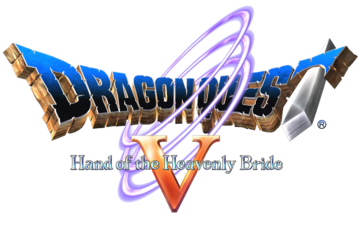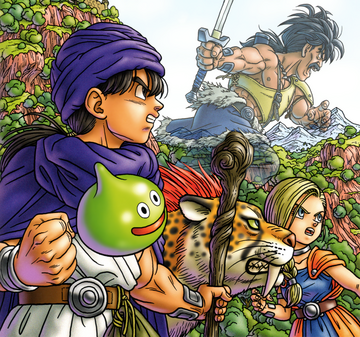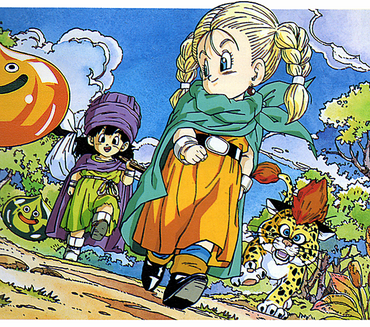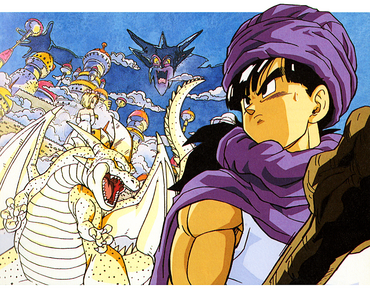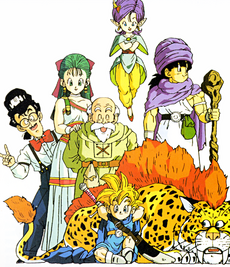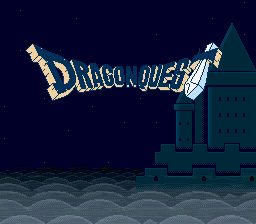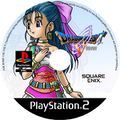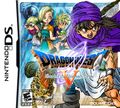Dragon Quest V: Hand of the Heavenly Bride
| Main series games | |
|---|---|
| Hand of the Heavenly Bride | |
| Developer(s) | Chunsoft ArtePiazza, Matrix Software (PS2) ArtePiazza, Cattle Call (NDS) |
| Publisher(s) | Enix Corporation (SFC) Square Enix (PS2, NDS) |
| Designer(s) | Yūji Horii |
| Artist(s) | Akira Toriyama |
| Composer(s) | Koichi Sugiyama |
| Series | Dragon Quest |
| Platform(s) | Super Famicom, Sony PlayStation 2, Nintendo DS |
| Release date(s) | Super Famicom JP September 27, 1992 PlayStation 2 JP March 25, 2004 Nintendo DS JP July 17, 2008 NA February 17, 2009 EU February 20, 2009 AUS February 19 2009 Android & iOS JP December 12, 2014 NA January 22, 2015 |
| Genre(s) | Console role-playing game |
| Mode(s) | Single player |
| Rating(s) | CERO: A (PS2, NDS) ESRB: E10+ (NDS) PEGI: 12+ (NDS) |
| Media | 16-megabit cartridge (SFC) DVD (PS2) Nintendo DS Game Card |
Dragon Quest V (ドラゴンクエストV 天空の花嫁 Doragon Kuesuto Faibu: Tenkū no Hanayome, lit. Dragon Quest V: Bride of Heaven) is the fifth installment in the Dragon Quest series, and the second of the Zenithian trilogy.
Dragon Quest V was the first game in the series in which certain monsters from random encounters may offer to join the player's party. This concept was an inspiration for the Pokémon video game series, which debuted several years after Dragon Quest V's release. Later, the same feature would spawn the Dragon Quest Monsters series in 1998.
On April 3rd, 2019 a trailer was released for Dragon Quest: Your Story, a feature film based on Dragon Quest V.
Setting
Dragon Quest V is set centuries after the Zenithian Hero defeated Psaro the Manslayer in the previous installment, Dragon Quest IV. The game starts on a sea vessel, with the Hero departing to go to Whealbrook. Like all other Dragon Quest games, this one takes place in a medieval world, with no real modern technology, such as cars or electricity. Characters fight with swords, clubs, and magic instead of guns or other weapons.
The layout of the world is superficially similar to the layout in Dragon Quest IV, but with a new set of locations, and considerable geographic alteration. The Stairway to Zenithia and Castle Zenithia itself are the only surviving locations from the previous game, and they have fallen into ruin and are no longer connected. The overworld has different monster encounter tables for each of the three eras.
The quest takes the Hero and his party to many exotic locations, such as a fairy village, a mansion made of ice, several caves, and even the depths of a volcano. The party eventually makes its way to the castle Zenithia, the hallmark of each game of the Zenithia trilogy. Like a few other Dragon Quest games, the final enemies reside in a dark world, separate from the main map.
Plot
Characters
- The Hero is, in the early chapters of the game, a six-year-old boy who travels all around the world along with his father, Pankraz. Though a child, he will become a capable warrior in his own right through exorcizing a haunted castle and saving the realm of the faeries from perpetual winter. After the tragic death of Pankraz at the end of the first generation, the Hero is forced into slavery, undergoing hard labor in the building of a temple. Ten years after, he finally escapes from there, and he starts a journey to find his mother, Mada, who was rumoured to have been kidnapped soon after the Hero was born. He will also search for the Legendary Hero that his father sought to find, and along the way discover love in the form of a heavenly bride.
- Pankraz is the father of the Hero. Though he was once the king of Gotha, he left his homeland to search for the Legendary Hero and his vanished wife. His attendant, Sancho, goes with him on his journey and resides in Whealbrook early in the game. He is a stern but kind man, with nearly all associated NPCs speaking very highly of him. In his travels, he keeps his kingly status a secret to avoid detection.
- Bianca is a daughter of the innkeepers of Roundbeck and the childhood friend of the Hero. When the hero and his father visit her in Roundbeck, she drags him off on a ghost-hunting dare to save a bullied Saber cub from it's aggressive owners. After growing up, she moves to a small village for recuperation of her injured father and matures into a kind and energetic countrywoman, becoming one of the women whom the player can choose to marry.
- Nera is a daughter of Rodrigo Briscoletti, who recently got back from domestic goddess training at Heaven's Above Abbey. She is the second choice for becoming the Hero's bride. Her father, Rodrigo Briscoletti (ルドマン Rudoman) is a wealthy man living in Mostroferrato (サラボナ Sarabona). He seeks his daughter's bridegroom, but will only accept a man who is able to pass his trial. Crispin Burns (アンディ Andi) a friend of Nera's, also desires to marry her.
- Debora is the older daughter of Mr. Briscoletti. She is introduced in the DS remake as a 3rd bridal candidate, however being a temperamental and spoiled girl, her parents have no real hope of finding her a suitor.
New features
Dragon Quest V follows in the footsteps of Dragon Quest IV by virtue of continuing Yuji Horii's narrative experiments. Rather than dividing the game into chapters focusing on several characters, the story exclusively follows the life of the person from childhood to adulthood, and finally to parenthood. This divides the game into 3 separate generations, with the world and characters ageing along with the protagonist. The nature of traversing the world's towns and combating monsters is still the same as in previous titles, but with the introduction of a well lauded addition to the series:
Monster recruitment
The largest gameplay addition was the inclusion of a monster recruitment system. Under this system, certain monsters may elect to join the player's party after being defeated in battle. These monsters then behave as typical player characters who can level up, use equipment, and receive orders/tactics in battle, but will often have abilities and resistances unavailable to human characters. This new feature adds a great deal of replay value as it greatly increases the possible party configurations a player can use.
In the original Super Famicom version, only 40 monsters were recruitable and 70 was the limit for how many could be kept in total. With subsequent remakes, these limits were raised to 70 recruits and 81 spaces respectively.
Player conveniences
- This game was the first to use katakana and numbers to name characters; earlier 8-bit games had only allowed the use of hiragana. Also, message windows can now display kanji. This significantly expanded the amount of text that could be stored to a cartridge without eating up space saved for music, graphics, and so forth, with the original advertisements stating the game had as much text as a novel.
- Search, Talk, and Open commands can now be issued by a single button press, bypassing the menu.
- The shop interface now shows what stat changes will occur when a weapon is equipped, and purchased items can be equipped automatically.
- Characters can now move a half-block tile at a time rather than only a full block, leading to smoother animation.
- Pots, barrels, and similar objects can now be Searched, and will often contain useful items. Unfortunately, this also meant that they sometimes contained monsters laying in wait...
Battle refinements and balancing
- For the first time, any character who is targeting an already-defeated monster will have their target automatically transferred to one of the other monsters (selected at random). In earlier games, the action was simply cancelled and the turn wasted.
- More advanced party AI than the previous game. An AI controlled character has been programmed to "learn" a foe's resistances and vulnerabilities much faster than before, avoiding infamous snafus such as a character wasting turns casting Whack on a boss monster. It is also possible, unlike in the previous game's original version, to set characters to manual command and allow them to be controlled individually as in the first three games.
- There is now a separation of spell resistances for monsters. In previous games, all spell resistance was based around accuracy, whereas in V an offensive spell's resistance is now calculated as damage reduction, thus preventing a caster from completely wasting their MP unless the foe is immune. This would set the precedent for resistances in all future titles and side games.
- There is now a distinct defensive stat in Resilience, determining a character's base defence; in earlier games, the base defence was calculated from Agility.
- Armour and shield resistance is now based on static number subtraction instead of a percentage. For example, the Magic shield will always reduce damage dealt from Sizz by 7 points.
- Boomerangs and whips can now attack groups of enemies. This feature leads to some weapons being replaced in remakes of older titles to avoid inconsistency.
- Some traditional spells had their effects slightly altered, such as Kabuff improving defence by 25% instead of 50%.
- The Zoom spell will take them to the town of their choice as in the later games. The Zoom spell can only be acquired at a certain stage of the plot (in the first half of the second generation); it cannot be acquired by levelling, and if a monster recruit learns this spell, the spell will not appear until after the plot event occurs. This marks the first time in the series that spell acquisition has been tied to plot events.
- Combat screens now have animated background images, reminiscent of the first game. The images depend on the local terrain and time of day. Also, attacking a monster or casting an offensive spell will produce a matching animation.
- The original SNES version only allows 3 active party members instead of 4; a 5-person wagon is still available, however. The PS2 and DS remakes restored party size to 4.
- The mechanism for replacing characters with reinforcements from the wagon was changed. It no longer takes a turn for a character to be swapped with one in the wagon, and it is possible to replace all characters at once. This significantly changes battle strategy, especially against major bosses. To balance this, several bosses possess much higher stats than were featured in previous games--hit points in particular.
New types of vehicles
In addition to the typical sailing vessel and flying mount, there are several additional modes of fantastical transportation. These new crafts carry their own restrictions but offer more intricate exploration.
- Flying Carpet: This whimsical rug can travel on grass, water, and shoals, and will suppress wandering monster encounters due to its high speed. It can be carried as an item, allowing it to be used anywhere where there is a sufficient region of grass to take off. However, it cannot travel through forests, so a line of forest inside a line of water (or vice versa) remains an impassible barrier.
- The Sky Castle: The home of the divine Zenithians can fly over any terrain; but it cannot reach or pass the high mountain on the central continent where the Great Temple is located. It can only land or take off from grass or desert (and only large areas of grass/desert, due to its size). The Zoom spell will not relocate the castle since you can instead Zoom directly into its control deck.
Knick-knacks
Introduced in the PS2 version, these locally-flavoured baubles provide an additional side-quest. Throughout the game, many special items called knick-knacks may be collected by the player. These items can be displayed in a special museum that will come under the ownership of the protagonist; NPCs will be attracted to the museum once it has exhibits, reminiscent of the boom town featured in other titles. Some special products will be upgraded by certain plot events, and can even be used as equipment in battle. Knick-knacks are unrelated to the overall plot of the game and exist only as a sidequest, but they offer a glimpse into the everyday life of an NPC that other games attempt to illustrate.
Translations
Dragon Warrior V has been used in 90's media as a reference to Dragon Quest V. In Enix America Corporation's newsletter Warrior World, the company revealed that they had decided against releasing Dragon Quest V as Dragon Warrior V in North America, and were planning to release Dragon Quest VI as Dragon Warrior V. Since Enix America Corporation ceased operations around the same time that Dragon Quest VI was released in Japan, official localization of the SFC title never occurred. The next title in the main Dragon Quest series to be released in North America was Dragon Quest VII as Dragon Warrior VII, during November 2001.
Fan translations of the SFC version of Dragon Quest V were later completed; both the DeJap/PT translation and byuu's translation were released on December 7, 2001. This translation utilized the spell and monster names codified in the older Enix localizations, but with much less censorship to death, other tragedies, and adult subject matter.
In February 2009, Square Enix released the DS remake, Dragon Quest V: Hand of the Heavenly Bride, the first official release of Dragon Quest V in English. This localization was created by Plus-Alpha, carrying over from their previous work in the series. As such, puns and onomatopoeia are commonplace, along with references to older titles. To great relief from fans, the Party Chat feature was retained for the overseas version, constituting nearly 1/3rd of the game's written script.
Remakes
PS2 remake
Main article: Dragon Quest V (PS2)
DS remake
A Dragon Quest V remake for the Nintendo DS was announced in late 2007 by Square Enix and was developed by ArtePiazza. The game uses the same engine as the DS remake of Dragon Quest IV.
On April 23, 2008, it was reported that Square Enix has applied for the trademark "Hand of the Heavenly Bride" at the United States Patent and Trademark Office. It was confirmed to be in reference to Dragon Quest V by a listing from Nintendo of third-party titles for Nintendo platforms. On the following day, Square Enix sent out a press release saying that the game will be released in Europe under the name Dragon Quest: The Hand of the Heavenly Bride.
The DS remake includes all the features of the PS2 remake, such as the expanded party size, plus a few new changes:
- An extra-difficult bonus dungeon, Estark's Labyrinth, is unlocked after completing the game.
- A third Heavenly Bride is introduced: Debora Briscoletti, the older sister of Nera. Unlike the other two brides, Debora is temperamental and intimidating, generally scaring off all potential suitors. Due to her aggressive personality, she is more of a physical fighter than the other brides, and can equip a wider selection of weapons.
- Debora appears along with Rodrigo & Nera at the start of Generation I.
- A new mini-game called Bruise the Ooze can be played, utilizing the DS stylus.
- Several more monsters are added and recruitable including: Archdemon & Jailcat
- Great sabrecubs are no longer encountered in the game, leaving Saber to be the only one.
- Healing Spells known by Pankraz and Honey can be used out of battle.
Mobile Phone port
Released in Japan on December 12, 2014, and over seas on January 22, 2015, this version is an enhanced, smoother looking port of the previous DS version. All features have been retained, with a few interface and presentation changes:
- Script alteration to reflect new control input.
- Smoother frame rate.
- Graphical upgrade.
- Improved audio quality.
- Reduced character sprite size in towns and the world map, making the game appear roughly 20% larger.
- Zoom and Evac's MP cost have now been reduced to 1 MP each.
- The creation and trading of personalized knick-knacks between players has been removed.
- Increased number of rolls for TnT boards.
Additionally, the Japanese version features a promotional campaign that allows players to register other DQ products in return for items and equipment not previously featured in V, such as the Gigant Armor and Dragon robe. No word as of yet if this will be made available after the promotion ends.
See also
Reception
Like the other games in the series, Dragon Quest V was very popular in Japan.In 2006, the Japanese gaming magazine Famitsu had readers vote on the top one hundred games of all time, Dragon Quest V coming in at 11 and the PS2 remake at number 40. In particular, the way the story is divided by different periods of time has been praised, as it is something that has not appeared in many video games. Dragon Quest V has also been acknowledged as Yuji Horii's favorite in the series, with him citing the appeal of seeing the protagonist grow from child to father.
Soundtrack
Koichi Sugiyama composed the music and directed all the associated spinoffs. A compilation of Dragon Quest V's music was put on the album Dragon Quest V ~Bride of the Heavens~ Symphonic Suite, was released in 1992 and then again in 2000. The first version features an extra disc with the original soundtrack as well as the symphonic one. Here is the track listing of the Symphonic Suite:
- Overture (1:59)
- Castle Trumpeter (2:21)
- Melody in an Ancient Town ~ Toward the Horizon ~ Casino ~ Lively Town ~ Melody in an Ancient Town (7:50)
- Magic Carpet ~ The Ocean (7:39)
- Melody of Love (3:00)
- Monsters in the Dungeon ~ Tower of Death ~ Dark World ~ Monsters in the Dungeon (6:20)
- Violent Enemies ~ Almighty Boss Devil Is Challenged (5:44)
- Noble Requiem ~ Saint (5:53)
- Satan (4:52)
- Heaven (2:57)
- Bridal Waltz (3:39)
Related media
Dragon Quest Tenkuu Monogatari (Tale of the Air) is a twelve-volume manga series based on Dragon Quest V by Chino Yukimiya, which ran in 1997, and again in 2001. The story follows Parry and Madchen, the two children from Dragon Quest V.
Trivia
A 2011 Japanese TV Drama Yuusha Yoshihiko to Maou no Shiro (勇者ヨシヒコと魔王の城 lit. "Hero Yoshihiko and the Devil's Castle") follows Hero Yoshihiko's story, who features Dragon Quest V Hero's costume.[1] A sequel Yuusha Yoshihiko to Akuryou no Kagi (勇者ヨシヒコと悪霊の鍵, lit. "Hero Yoshihiko and the Evil Spirit Key") was released in 2012.[2]
